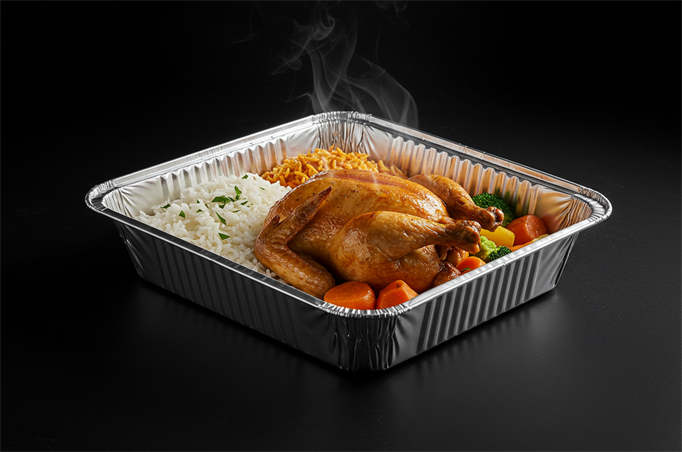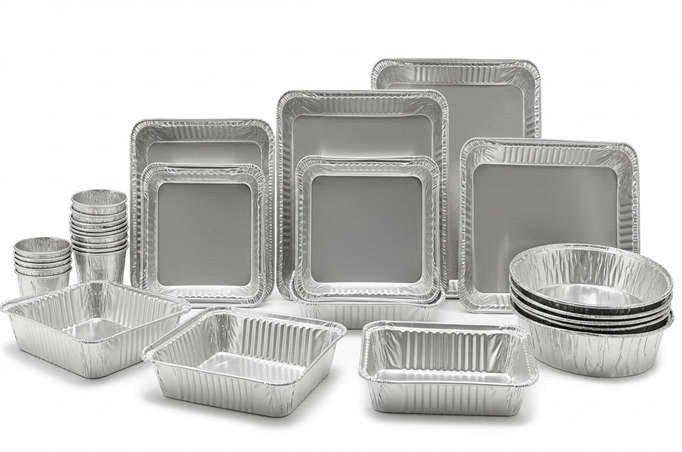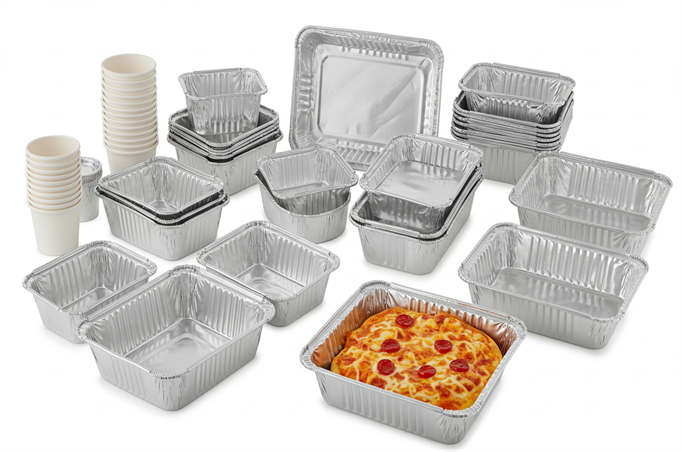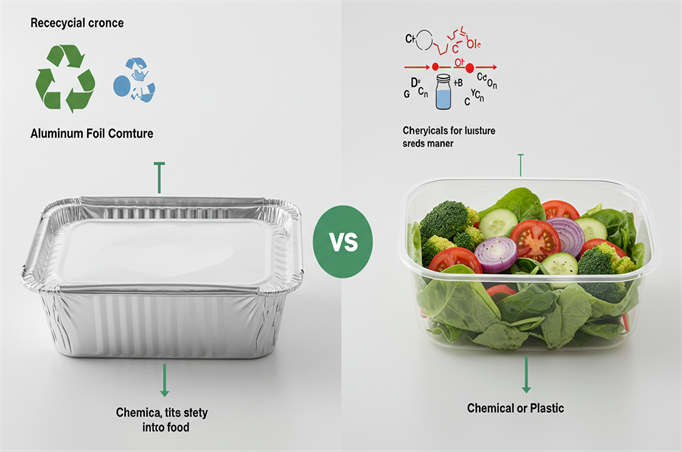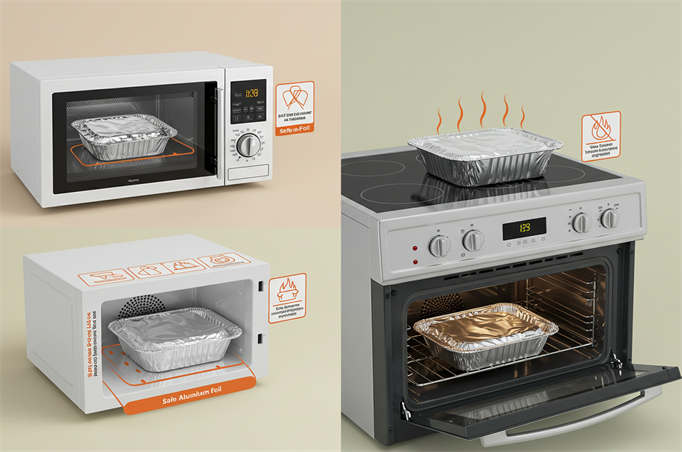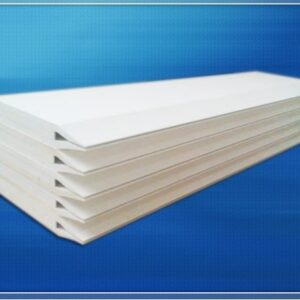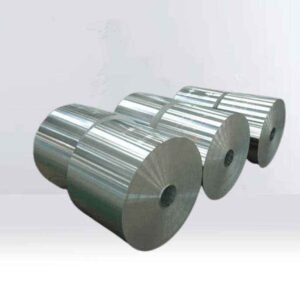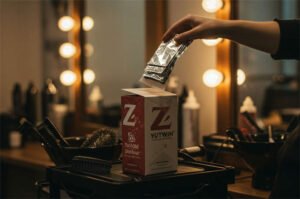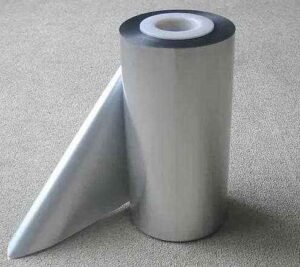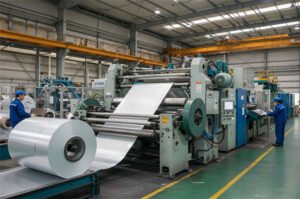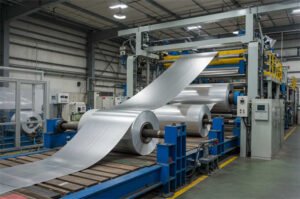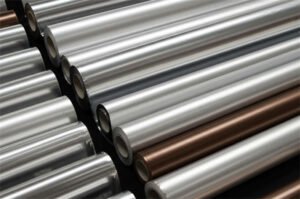Today, I’d like to have a quick, friendly chat about the humble recipiente de papel de aluminio that appears in so many kitchens, food trucks, and delivery bags. Ever open a steaming box of lasagna, dumplings, or spicy curry and wonder, “Is this shiny tray okay for my hot dinner?” You’re not alone. We hear the same questions every day: “Will the metal melt?”
“Does aluminum sneak into my food?” “Can I pop it straight into the oven?” So we sat down, poured ourselves a cup of coffee, and wrote this easy-to-read guide to clear up the confusion—no science degree needed.
Think of this blog as the five-minute conversation you’d have with a friend who works in a foil factory. We’ll explain why a food-grade aluminum foil container is safe up to 250 °C, how to spot the good stuff from the sketchy stuff, and which foods need a simple piece of baking paper as a “bodyguard.”
We’ll even show you why the shiny side and the dull side are twins—one likes to dress up more. By the end, you’ll know exactly when your recipiente de papel de aluminio is your best friend (hello, crispy baked wings) and when it’s better to choose glass or ceramic (sorry, lemon-garlic shrimp). Ready? Let’s unwrap the facts together.
At Yutwin Aluminum Foil, we understand you want to ensure your food is safe, practical, and eco-friendly when using aluminum foil containers for hot food. Here’s what you need to know and our recommendations:
1. Confirming Safety
- Food-Grade Material: Always ensure your containers are made from papel de aluminio alimentario (typically marked “Food Grade” or compliant with GB/T 3190-2020 standards). Avoid industrial-grade aluminum foil, which may contain impurities like lead or cadmium.
- Resistencia a la temperatura: Aluminum foil melts at 660°C. It can withstand high temperatures below 250°C for short periods (like in ovens or steamers). However, avoid direct contact with open flames or temperatures exceeding 300°C, as this can cause melting or deformation.
- Coating Selection: Some aluminum foil containers have a high-temperature-resistant coating (such as PE or PP film) on the inner layer. Este prevents acidic foods (such as tomato sauce) from corroding the aluminum. Confirm the coating is food-grade and heat-resistant (usually ≤120°C).
2. Recommended Usage Scenarios
- Takeout/Packaging: Choose aluminum foil boxes with clasps (like those used for airline meals) to prevent soup leakage. Pair them with paper tote bags for insulation to avoid burns.
- Oven/Steamer Use: Use wrinkle-free aluminum foil containers (with smooth edges) to prevent cuts. You can cover the food with a layer of parchment paper to prevent sticking and avoid direct contact between the food and the aluminum foil.
- Refrigeration and Reheating: Aluminum foil can withstand temperature differences from -20°C to 250°C. Este makes it ideal for refrigerating and then directly reheating food in an oven or steam cabinet without transferring it to another container.
3. Environmental Considerations & Alternatives
- Recycling: Aluminum foil is 100% recyclable; however, clean it off before disposal to remove oil stains. For heavily soiled containers, dispose of them as general waste (some cities may have specific requirements).
- Alternative Materials: If you need to microwave your food (aluminum foil is not microwave-safe), switch to PP5 plastic containers or molded plant fiber containers (like sugarcane pulp). However, these have lower heat resistance (≤120°C).
4. Important Precautions
- Avoid Long-Term Storage of Acidic/High-Salt Foods: Foods like lemon juice or pickles can corrode aluminum foil, potentially leading to aluminum leaching (though the risk is extremely low for short-term contact).
- Children’s Use: The edges can be sharp. We recommend choosing aluminum foil bowls with rolled edges or using them with paper bowl holders for a more secure fit.
Summary & Recommendations
- Brand Reference: Choose food-grade brands like Handi-Foil, Reynolds Wrap, and Papel de aluminio Yutwin. For domestic procurement, select compliant manufacturers, such as Cosco.
- Specification Selection: Common capacities range from 500ml to 2000ml. For takeout, a common choice is the 750ml rectangular aluminum foil box with a lid, measuring approximately 18 cm × 13 cm × 5 cm. These typically cost around $0.04 – 0.07 per piece (wholesale price).
- If you need further customization (such as logo printing or special sizes), contact aluminum foil product manufacturers (like Yutwin Aluminum Foil) for MOQ (Minimum Order Quantity), which is usually 5000 pieces or more.
Is It Safe to Use Aluminum Foil Containers for Hot Food?
Yes, using aluminum foil containers for hot food is generally safe when used correctly.
✅ Scientific Basis for Safe Use
- High Material Stability: Aluminum foil has a melting point of 660°C. Its structure remains stable at regular hot food temperatures (≤250°C), and it will not release toxic substances. Its surface oxide film (aluminum oxide) prevents further corrosion. It complies with food-grade standards, meeting the requirements for heavy metal content (lead and cadmium ≤ 0.01%).
- Authoritative Certification: The FDA and the European Food Safety Authority (EFSA) both recognize the Safety of food-grade aluminum foil. They stipulate a maximum weekly aluminum intake of 2 mg/kg body weight (for a 70 kg adult, the limit is 140 mg/week). Normal use falls well below this limit.
- Extremely Low Risk for Short-Term Contact: Experiments have shown that when neutral food is heated at 200°C for 2 hours, aluminum migration is less than 0.2 mg/kg, which is only a tiny fraction of the safety limit.
⚠️ Scenarios to Avoid
| Risky Behavior | Consequence | Recommendation |
| Direct contact with strong acids/high-salt foods (e.g., tomatoes, pickled fish) | Aluminum leaching increases 3-5 times | Switch to coated papel de aluminio or glass containers. |
| Open flame grilling or prolonged heating above 250°C | Localized melting or formation of unknown compounds | Keep oven temperatures below 200°C. |
| Microwave heating (without removing lid or empty container) | Arcing, container deformation | Never microwave. Remove lid and fill with food. |
| Long-term storage of acidic foods | Chronic aluminum intake accumulation (caution for kidney patients) | Transfer to a neutral container (e.g., ceramic) promptly. |
🛡️ Safe Usage Guidelines
- Choose Quality Products: Look for the “Food Contact Use” label. Avoid inferior aluminum foil, which may contain excessive heavy metals.
- Use Isolation Measures: When grilling, place a layer of parchment paper between the aluminum foil and the food to reduce direct contact.
- Special Populations: For individuals with impaired kidney function and infants, we recommend prioritizing the use of glass or stainless steel containers.
Aluminum foil containers are suitable for takeout and reheating in the oven. As long as you avoid acidic/high-salt foods and extreme temperatures, global authorities endorse their Safety. With reasonable use, you don’t need to worry excessively about health risks.
Which Side of Aluminum Foil is Suitable for Hot Food?
Aluminum foil containers do not have a front or back side; you can safely use both sides in direct contact with hot food. Their safety performance is identical.
While aluminum foil has a shiny side and a dull side, this is simply a surface difference resulting from the manufacturing process, not a functional distinction. The glossy side comes from being pressed by polished rollers, while the dull side is the one that contacts another sheet of aluminum foil. Both sides have the same material, heat resistance, and Safety.
However, based on experience, we suggest using the dull side to contact food because:
- The dull side is slightly rougher, making it less likely for food to stick.
- The shiny side has a slightly higher reflectivity, making it more suitable for facing outwards to reflect heat and improve heating efficiency.
Este is merely a usage suggestion, not a safety requirement. As long as it’s food-grade aluminum foil, it will not release harmful substances, regardless of which side comes into contact with hot food.
How to Identify Food-Grade Aluminum Foil
At Yutwin Aluminum Foil, we want you to be confident in your choice. Here’s how you can identify food-grade aluminum foil:
✅ 1. Check the Markings: Look for “Food Contact Use”
- Domestic Standards: Our products comply with GB/T 22647-2008 “Aluminum and Aluminum Alloy Foils for Flexible Packaging.” The product or packaging should explicitly state: “Food Contact Use” o “Food Contact Safe.”
- Estándares internacionales: We also adhere to EU standard EN 602-2007 and US standard FDA 21 CFR §178.3297. Compliant products will typically state this on their packaging or instructions.
✅ 2. Review the Test Report: Confirm Heavy Metal Limits
Food-grade aluminum foil must pass the following key inspection items before it can be sold:
| Test Item | Limit Standard (China) |
| Aluminum Migration | ≤1 mg/dm2 (simulant solution) |
| Lead (Pb) | ≤0.01 mg/kg |
| Cadmium (Cd) | ≤0.002 mg/kg |
| Mercury (Hg) | ≤0.01 mg/kg |
| Chromium (Cr⁶⁺) | ≤0.1 mg/kg |
Reputable manufacturers, such as Yutwin Aluminum Foil, provide third-party test reports (e.g., SGS, CTI). You can always request to view them.
✅ 3. Observe Appearance and Feel
- Surface: Food-grade aluminum foil appears bright and smooth, with no black spots, oil stains, or unusual odors.
- Grosor: Household or meal box-grade aluminum foil typically has a thickness of 0.006–0.02 mm. Too thin, and it tears easily; too thick, and it might not be food-grade.
- Edges: Rolled edges are neat and free of burrs. Inferior aluminum foil often has jagged or torn edges.
✅ 4. Check Source and Brand
- Prioritize Well-Known Brands: Choose brands like Reynolds Wrap (USA), Handi-Foil, and especially Papel de aluminio Yutwin, as well as other qualified manufacturers like Xiamen Xiashun Aluminum Foil. These companies have food-grade certification qualifications.
- Beware of “Three-No” Products: Aluminum foil without a manufacturer’s name, standard number, or “Food Contact Use” labeling is very likely industrial grade and poses a risk of heavy metal contamination.
✅ Quick Identification Tips
Check the label, review the report, feel the texture, and ask about the source.
When purchasing online, we recommend asking the seller for a screenshot of the test report or a photo of the packaging’s front to confirm the “Food Contact Use” labeling before making a purchase.
Can Aluminum Foil Leech into Food?
Yes, aluminum foil can indeed leech into food under certain conditions. The risk is higher in the following three situations:
✅ Three Typical Scenarios Where Leaching Occurs
| Situation | Mechanism | Ejemplos |
| Alimentos ácidos | Acidic components break down the aluminum’s surface oxide layer, causing aluminum ions to leach out. | Lemon juice, tomato sauce, pickled foods |
| High-Salt Foods | Chloride ions accelerate electrochemical reactions, promoting aluminum migration. | Cured meats, pickled fish, soy sauce-based soups |
| High-Temperature, Long-Duration Cooking | Increased temperature speeds up metal migration rates. | Foil-wrapped potatoes, roasts cooked for over 2 hours |
⚠️ Experimental Data Examples
- A study published in “Food Chemistry” found that when baking lemon chicken wrapped in aluminum foil at 200°C for 1 hour, aluminum migration could reach 2–6 mg/kg, significantly higher than samples not wrapped in foil.
- The Swedish National Food Agency notes that when aluminum foil comes into contact with stainless steel containers in the presence of moisture, galvanic corrosion can occur, leading to a significant increase in aluminum leaching.
✅ Safety Recommendations
- Avoid Direct Contact: For acidic or high-salt foods, first use parchment paper or a glass container to create a barrier.
- Control Temperature and Time: Keep oven temperatures at ≤200°C and heating time under 1 hour.
- Special Populations: Individuals with impaired kidney function and infants should try to avoid cooking with aluminum foil.
The risk is extremely low for everyday, short-term use of aluminum foil (e.g., baking chicken wings for 20 minutes). However, with a combination of high temperatures, high acidity or salt, and prolonged exposure, aluminum can indeed leach into food. By reasonably avoiding the situations mentioned above, you can use aluminum foil safely.
Can Aluminum Foil Harm Our Health?
The current scientific consensus is that aluminum foil itself is non-toxic; however, incorrect use can indeed harm your health.
✅ Normal Use → Extremely Low Risk
Food-grade aluminum foil has a dense oxide layer on its surface. Short-term contact with neutral foods or room-temperature packaging will not release aluminum ions and will not harm your health.
The WHO sets a tolerable daily intake of aluminum for adults at 0–0.6 mg/kg body weight (for a 60 kg adult, this is approximately 36 mg/day). The amount of aluminum migrating from foil during normal use is typically far below this limit.
⚠️ Incorrect Use → Potential Health Hazards
| High-Risk Scenario | Mechanism | Consequence |
| High heat + acidic foods (e.g., lemon chicken, tomato sauce) | Acid breaks down the oxide layer, and high temperatures accelerate migration | Aluminum leaching can increase by 2–4 times |
| Prolonged grilling/open flame | Localized melting, unknown compound formation | Additional chemical risks |
| Low-quality papel de aluminio | Heavy metal impurities (lead, cadmium) exceed standards | Risk of chronic poisoning |
| Individuals with impaired kidney function | Aluminum excretion is hindered | Aluminum accumulation in the body, potentially affecting bones and the nervous system |
🔍 Quick Look at Research Data
- Experiments show that baking red meat at 250°C for 20 minutes can increase its aluminum content by up to 378%.
- Epidemiological studies suggest a correlation between long-term high aluminum exposure and an increased risk of Alzheimer’s disease and osteomalacia, but a “causal” link has not yet been definitively established.
✅ 4 Principles for Safe Use
- Avoid direct contact with acidic or high-salt foods; use parchment paper as a barrier if necessary.
- Control temperature to ≤200 °C and time to ≤1 hour.
- Purchase products with food-grade labels from reputable brands and refuse products with “three-no” labels.
- Special populations (those with kidney disease, infants) should try to use glass, ceramic, or stainless steel containers instead.
Using compliant aluminum foil correctly will not harm your health.
Only under combined conditions of high Temperature, acidity, prolonged exposure, or with inferior aluminum foil will aluminum migration significantly increase. Only prolonged exposure under these conditions may lead to long-term health risks affecting the nervous system, bones, and other areas.
What Should You Pay Attention to When Packaging Food with Aluminum Foil?
At Yutwin Aluminum Foil, please use our products safely and healthily. To ensure this, please keep these seven core precautions in mind when packaging or heating food with aluminum foil:
- Avoid Contact with Strong Acids, Strong Alkalies, or High-Salt Foods:
- Reason: Acidic or high-salt environments can damage the oxide film on the aluminum foil’s surface, causing aluminum ions to migrate into the food.
- Typical Foods: Lemon juice, tomato sauce, vinegared foods, salted egg yolks, cured meats, etc.
- Recommendation: Use parchment paper or a glass container as a barrier before wrapping with aluminum foil.
- Control Heating Temperature and Time:
- Maximum Temperature: ≤200°C in ovens/steamers. Avoid direct contact with flames when grilling over an open fire.
- Maximum Time: Continuous heating for ≤1 hour. The higher the Temperature, the shorter the heating time should be.
- Risk Warning: Localized melting or reactions with impurities in charcoal can produce unknown compounds.
- Do Not Use in Microwave Ovens:
- Prohibition: Do not place aluminum foil boxes, bags, or sheets directly in a microwave oven; metal reflects microwaves, creating arcs that can damage the oven or even cause an explosion.
- Exception: If your microwave oven’s instructions explicitly allow the use of aluminum foil, you must meet these conditions:
- Food fills ≥80% of the volume.
- The lid is completely open or replaced with microwave-safe plastic wrap.
- The aluminum foil box is maintained at a distance of at least 2 cm from the oven walls, and a ceramic plate is placed underneath.
- Ensure Food Fills the Container:
- Reason: Unfilled aluminum foil boxes can experience localized overheating in ovens or microwaves, leading to charred food or even fires.
- Recommendation: If the food quantity is insufficient, you can fill the empty spaces with oven-safe vegetables or rice.
- Use Only Food-Grade, Undamaged Aluminum Foil:
- Identification Method: Look for packaging printed with “Food Contact Use” or compliance with standards like GB 4806.9-2016 or FDA 21 CFR §178.3297.
- Reject: Old aluminum foil or recycled aluminum products with scratches, tears, oil stains, or unusual odors on the surface.
- Do Not Reuse Disposable Aluminum Foil Containers:
- Reason: Repeated heating and cooling can weaken the aluminum foil’s structure, increasing the risk of metal migration and micro-cracks.
- Eco-Friendly Disposal: Clean them and place them in the metal recycling bin. Please do not reuse them for cooking.
- Special Populations Should Use with Caution:
- Individuals with impaired kidney function, infants, and pregnant women: We recommend using glass, ceramic, or stainless steel containers instead to reduce the risk of cumulative aluminum intake.
“Aluminum foil itself is safe; the key lies in the correct scenario, correct temperature, and correct food.”
Here we are at the bottom of the page, and your worries are at the bottom of the trash bin. Remember: a quality recipiente de papel de aluminio is like a reliable umbrella—when you open it the right way, it keeps everything safe and dry. Use it within 200 °C. Keep super-acidic foods wrapped in parchment first, and always look for the “food contact safe” stamp. Do that, and you’ll stay well inside the safety limits set by the world’s top food agencies (yes, even stricter Auntie FDA).
Before you run off to reheat last night’s pad thai, let me leave you with three tiny habits that make a big difference: ① Check the label once—just once—when you buy; ② Fill the tray at least halfway so heat spreads evenly; ③ Toss the used box in the metal-recycle bin after one go. That’s it. No rocket science, just everyday common sense.
If you ever need more tips, custom sizes, or a batch of envases de papel de aluminio printed with your restaurant’s logo, you know where to find us—Yutwin Aluminum Foil is always one email away. Until then, happy cooking, happy eating, and may every delivery arrive hot, tasty, and perfectly safe.
FAQ: Aluminum Foil Container & Hot Food Safety
1. Are aluminum foil containers safe for hot food?
Yes. Food-grade aluminum foil containers are stable between –20 °C and 250 °C and will not release harmful substances when used correctly.
2. How can I tell if my foil container is food-grade?
Look for the words “Food Contact Safe,” “FDA compliant,” or the GB/T 22647-2008 mark on the box or packaging. Reputable brands will also provide third-party lab reports upon request.
3. Can I put an aluminum foil container straight into the oven or microwave?
Oven: Yes, up to 250 °C.
Microwave: Use only in convection or grill mode. Remove the lid, fill at least 80% of the volume, and keep the box 2 cm away from the oven walls to avoid sparks.
4. Do acidic foods like tomatoes or lemons react with aluminum?
They can. Prolonged contact with high-acid or high-salt foods may increase aluminum migration. Place a sheet of baking paper between the food and the foil to prevent it from sticking.
5. Is it true that aluminum leaks into food?
Under normal use, the amount is tiny (well below WHO’s 2 mg/kg weekly limit). Migration occurs only when high heat (>200 °C), prolonged cooking times, and strong acids are combined.
6. Can I wash and reuse a take-out aluminum box?
No. Repeated heating and cooling weaken the metal, increasing the risk of cracks and leaching. Clean and recycle the box after each use.

